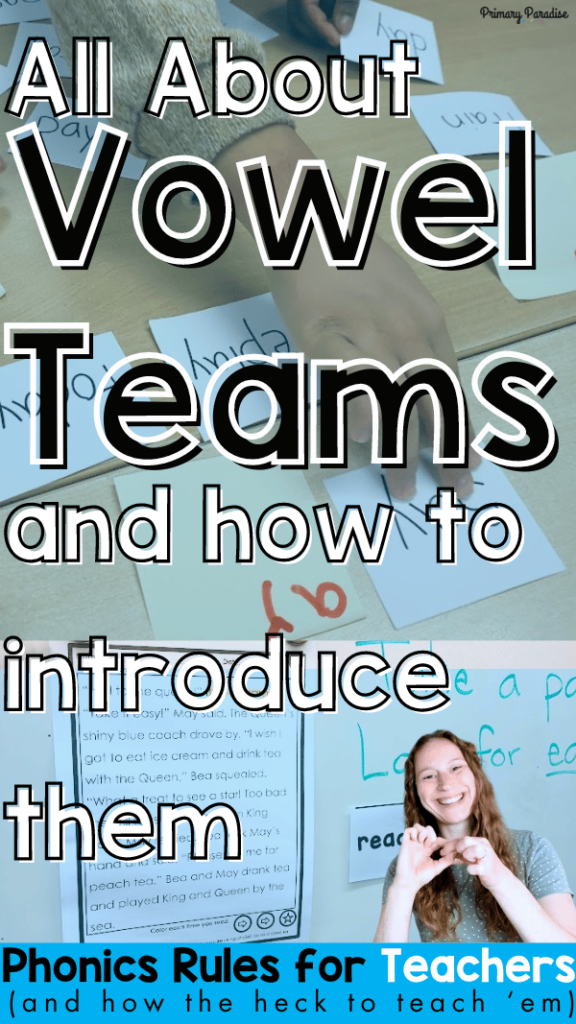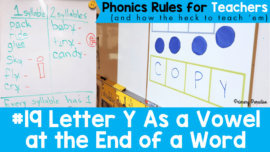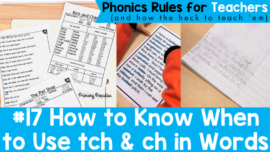Understanding the vowel team syllable can seem complex. There are many vowel teams in the English language, so how can we teach vowel teams to our students? Let’s look at what a vowel team is generally and how to introduce this syllable type in your classroom.
This is post 20 in my series Phonics Rules for Teachers (and How the Heck to Teach ‘Em). If you’d like to see previous posts, you can click here.
Would you rather listen or watch? Find a podcast version of this blog post, or watch the video below.
What is a vowel team?
A vowel team is when we have two or more letters working together to spell a vowel sound. Vowel teams can represent long vowels, shorts vowels, and other vowel sounds. They can often spell more than one vowel sound- for example ow spells both the long o sound as in snow and the /ow/ sound as in now.
Vowel teams typically contain letters we think of as vowel letters- a e i o u y, but can also include other letters as well- for example, we see w as part of vowel teams. Sometimes letters that typically spell consonant sounds are found in vowel teams such as the vowel teams igh and al.
Most of the time, vowel teams contain two letters, but some vowel teams include 3 or 4 letters- for example igh and ough.
Examples
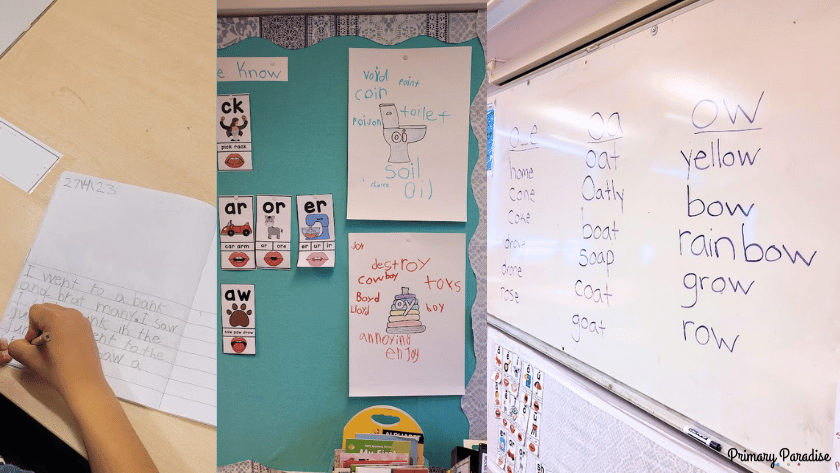
There are over 20 vowel team spellings the English language, and multiple vowel teams can often spell the same sound. Multiple vowel teams can spell multiple sounds as well.
- long a vowel teams- ai, ay, ei, eigh, ea, ey
- long e vowel teams- ee, ea, ie, ei, ey
- long i vowel teams- igh, ie
- long o vowel teams- oa, ow, oe
- long u vowel teams- ue, ui, eu
- diphthong vowel teams- au, aw, oi, oy, oo (book), oo (moo), ew, ou, ow, ough, augh
- short vowel vowel teams- ea (short e), ou (short u)
The order to teach vowel teams
When teaching vowel teams, it’s important to follow the principle I’ve shared from the beginning of Phonics Rules for Teachers which is this: We start with the simplest and most common spelling patterns and move to the less common and more complex spelling patterns. We move from simple/common to complex/rare.
While different programs follow different orders, following a consistent and logical scope and sequence is the most important thing. Personally, I prefer to begin with common, long vowel teams since students are already familiar with long vowel sounds (if you’re following my suggestion of teaching closed syllables, open syllables, and then silent e syllables.) Once students are comfortable and confident with those, you can move on to the most common diphthong vowel teams. I typically like to move on to r controlled syllables, and then, once students have a strong understanding of them, you can continue with more complex vowel teams as well as the final le syllable.
Here is an example of an order to teach vowel teams.
- ee (bee)
- ai (pain)
- ay (pay)
- ea (pea)
- oa (boat)
- ow (snow)
- ie (pie)
- ue (glue)
- igh (right)
- y (by)
- y (baby)
- oo (pool)
- oo (book)
- aw (saw)
- au (cause)
- ew (new)
- oi (coin)
- oy (toy)
- ou (ouch)
- ow (cow)
Here, it might be appropriate to move on to r controlled vowels, and then come back to these lesson common vowel teams.
- ea (steak)
- ea (bread)
- ie (field)
- eigh (eight)
- ey (they)
- ei (receive)
- oe (toe)
- ui (fruit)
- ough (various sounds)
- augh (aw)
You can see the frequency of different spelling patterns, including these vowel teams on this list compiled through the research of Francine Johnson.
How to Teach Vowel Teams to Your Students

Vowel teams are such commonly used spelling patterns. They open up a world of new words for your students to read and right. The tricky thing about this spelling pattern is that there are many vowel teams, they can spell various sounds, and students need to learn each pattern individually. This is why it’s best to focus on each vowel team one by one.
How to introduce vowel teams to your students
Before introducing vowel teams, take some time to review the syllable types you’ve already learned. If you’ve already taught consonant digraphs, your students should be aware that letters can work together to spell a sound. Explain to students that you’re going to teach them about a new syllable type where letters work together to spell a sound.
Write some words with consonant digraphs on the board such as then, wish, and chat. Ask students which letters are working together to spell a sound- th, sh, and ch. Tell them that today you’re going to look at a new syllable type. Explain that, like a consonant digraph, we will see letters working together to spelling a sound. However, this time, we will have letters working together to spell a vowel sound. Write a word with whatever vowel team you will be teaching first. For example, if you’re teaching ee, you can write peek.
Point out the 2 ee’s and explain that ee is working together to spell the long e sound.
Use hand motions
Next, you can teach your students these hand motions to explain vowel teams. Have them hook two fingers together to make a chain and say “vowel team”. It’s helpful to explain that, often we have 2 letters working together, but it can 3 or 4.
Practice, Practice, Practice
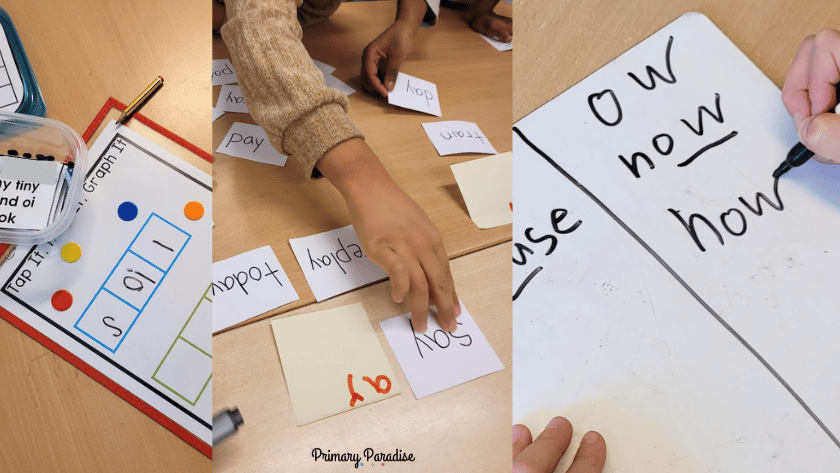
Make a list together of words containing the vowel team you’re focusing on first. So, if you’re working on ee, you might have bee, meet, sleep, free, need, bee, feed, green, and so on.
From there, you can practice with any of these 12 strategies as you can do with every new sound. After your students have mastered the first vowel team, you can add it to your daily sound drill (explained in the link above) and continue on to the next vowel team.
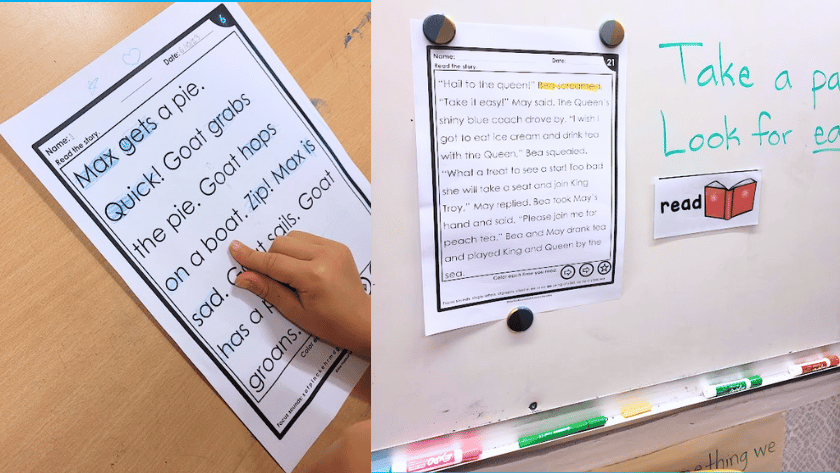
As with any new sound, the key is to practice in context so students can get comfortable with the spelling pattern.
